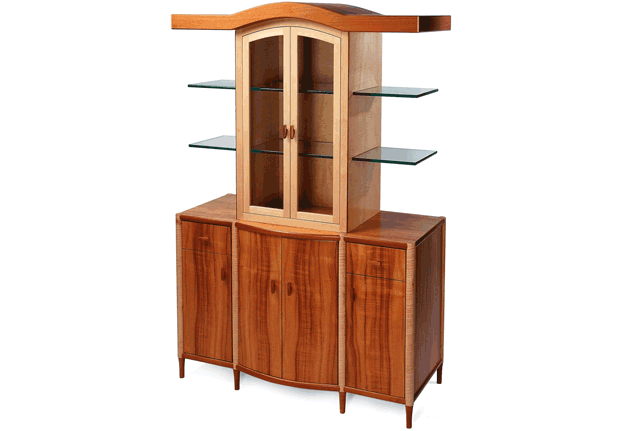
That strange description is what really caught our attention when we were rifling through the various furniture makers that were exhibitors at the recent Philadelphia Furniture and Furnishings Show. So we called Michael Gloor, principal at Gloor Design in Peace Dale, Rhode Island, to get an explanation.
Michael stood steadfastly by that description of his furniture and told us why. He’s always been a fan of Japanese and Asian design and tries to approach all of his pieces with a studied understanding of the oriental aesthetic. That means making something beautiful at the same time you’re making it functional. The pieces of oriental furniture he’s studied have “a certain massiveness to them, but they also have a grace and poise that really appeals to me… [the Japanese] approach things with an almost spiritual reverence for the material.”
On the Shaker side, Michael has been very influenced by the utilitarian philosophy of that school of furniture making (see upcoming article on Shaker furniture in the September isssue of Woodworker’s Journal by Joanna Takes). But a lot of Shaker furniture was a bit too severe for him, so he softened his pieces, and ended up with what he calls Neo Shaker. He also admits, though he’s not fond of the style, that some of his projects have an Art Deco flavor to them. That comes, he says, from the very showy veneers he can’t help but incorporate into his work.
Let the Tree Talk
Michael feels a certain awe when he spots a particularly interesting piece of veneer, and that’s why he likes to get it out there where people can see it. “To me, it’s like some tree grew this and it blows me away. So let’s let the tree do some talking here,” he says excitedly.
In his Curved Front Bureau (above), for example, Michael found some very rare birds-eye elm, book matched it, and used the lighter sapwood in the veneer to create the lighter line down the middle. “It’s very simple and yet there’s a whole lot going on,” says Michael of that particular piece.
Veneer is great, he says, because it allows him to use a lot of exotic, rich woods. But it also helps him create more stable pieces of furniture. He uses solid wood for the corner posts and such, but turns to veneer over a substrate for large panels.
Subtle Details
When his pieces of furniture are really working well, Michael says, “they don’t just jump out and slap you in the face. I like a lot of little nuances going on.” He tells the story of one client who bought a writing desk from him. It was a combination of mahogany and plane tree* veneer and the customer called him three months after it was delivered and said “Hey, I just noticed these little inlays on the legs.” Michael had added some small walnut inlays on the mahogany legs of the desk that were very subtle. “That’s what I want my furniture to be,” he says, “basically the longer you’re with it, the more you like it.”
He also wants his work to be very tactile. That comes from his background working with clay and porcelain. He graduated from the Kansas City Art Institute with a particular focus on clay, and that’s where his interest in Japanese design began and flourished. His work with clay also helped him when he started building furniture. “In a way, it helped me to think expansively, because as a furniture maker, I’m self-taught. So I didn’t learn any of the constraints you might learn in a furniture school,” says Michael.
He took to doing some carpentry work after school to pay the bills, and one thing led to another. Actually, the framing work he did led to more finish and cabinet work. That led to more custom kitchens and some stair work. Michael even squeezed in some boat work in his woodworking career before finally hitting on designing and building furniture for the last five to six years. He admits that “I get bored easily so I just wanted more and more challenges.”
One of the best compliments he got about his furniture was at the Providence Furniture Show. A blind man came by the booth when he was gone and had been sitting in some of his chairs. When Michael returned, the man told him “I love your work. It feels great.” That feeling was something he had been working to achieve with his furniture, so Michael really appreciated the man’s comment. “If you’re sitting at a desk,” he says, “it should feel good to you. You should want to touch it. It’s just like when you pick up a coffee cup and it’s handmade, your hand should like holding it.”
*The plane tree (of the genus Plantunus) includes both the Oriental Plane and the American Sycamore.





